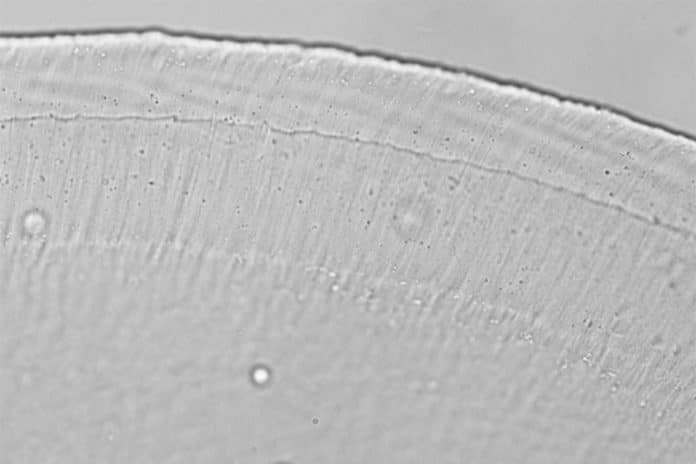The human ear, similar to those of different mammals, is so uncommonly delicate that it can detect sound-wave-induced vibrations of the eardrum that move by not exactly the width of an atom.
MIT scientists now get detailed insights into how the ear achieves this amazing ability to pick up faint sounds.
Our inner ear has a minuscule gelatinous structure called tectorial membrane. This tectoria membrane is responsible for the ear’s sensitivity and its selectivity. Now, MIT scientists have found a gel membrane that is responsible for extreme sensitivity to the sound we listen.
The sensitivity has to do with the size, stiffness, and distribution of nanoscale pores in that membrane, and the way those nanopores control the movement of water within the gel.
The tectorial membrane lies atop the tiny hairs that line the inner ear or cochlea. These sensory receptors are arranged in tufts that are each sensitive to different frequencies of sound, in a progression along the length of the tightly curled structure. The fact that the tips of those hairs are embedded in the tectorial membrane means its behavior strongly affects the way those hairs respond to sound.
Senior author Dennis Freeman said, “Mechanically, it’s Jell-O- which is thinner than a hair. Though it’s essentially a saturated sponge-like structure made mostly of water, if you squeeze it as hard as you can, you can’t get the water out. It’s held together by electrostatic forces.”
“But though there are many gel-based materials in the body, including cartilage, elastin, and tendons, the tectorial membrane develops from a different set of genetic instructions.”
Lead author Jonathan Sellon, professor of electrical engineering said, “The purpose of the structure was a puzzle initially. “Why would you want that?” Sitting right on top of the sensitive sound-pickup structure, it’s the kind of thing that muffles most kinds of microphones. Yet it’s essential for hearing, and any defects in its structure caused by gene variations can significantly degrade a person’s hearing.”
After detail understanding, scientists found that the size and arrangement of pores inside it, and the manner in which those properties influence how water inside the gel moves forward and backward between pores in light of vibration, makes the reaction of the entire framework exceptionally particular.
Both the most noteworthy and least tones coming into the ear are less influenced by the amplification given by the tectorial membrane while the center frequencies are all the more firmly enhanced.
Scientists found that the tectorial membrane’s structure looked like a solid but behaved like a liquid— which makes sense since it is composed mostly of liquid.
Freeman said, “What we’re finding is that the tectorial membrane is less solid than we thought. The key finding was that for middle frequencies, the structure moves like a liquid, but for high and low frequencies, it only behaves as a solid.”
“A better understanding of these mechanisms may help in devising ways to counteract various kinds of hearing impairment — either through mechanical aids such as improved cochlear implants, or medical interventions such as drugs that may alter the nanopores or the properties of the fluid in the tectorial membrane. If the size of the pores is important for the functioning of hearing, there are things you could do.”

John S. Oghalai, a professor and chairman of the department of otolaryngology at the University of Southern California said, “This is really wonderful work. The mechanical nature of the nanoscale structures of the inner ear is extremely hard to study but critically important to hearing.”
“In this study, the authors show that the proteins within the tectorial membrane and the fluid interspersed between them are ‘tuned.’ This may finally explain how each hair cell is stimulated at its correct frequency.”
“This research is of the highest quality. Not only were exquisite experiments performed, but the data were also modeled mathematically to develop a deep understanding of their implications.”
“One thing that remains to be done, he says, is that since these tests were done on excised tissue, it remains to be seen whether these findings are relevant in the normal inner ear of living animals.”
Other authors of the paper include Mojtaba Azadi, Ramin Oftadeh, and Alan Grodzinsky at MIT and Hadi Tavakoli Nia at Massachusetts General Hospital and Harvard Medical School. The results appear in the journal Physical Review Letters.
